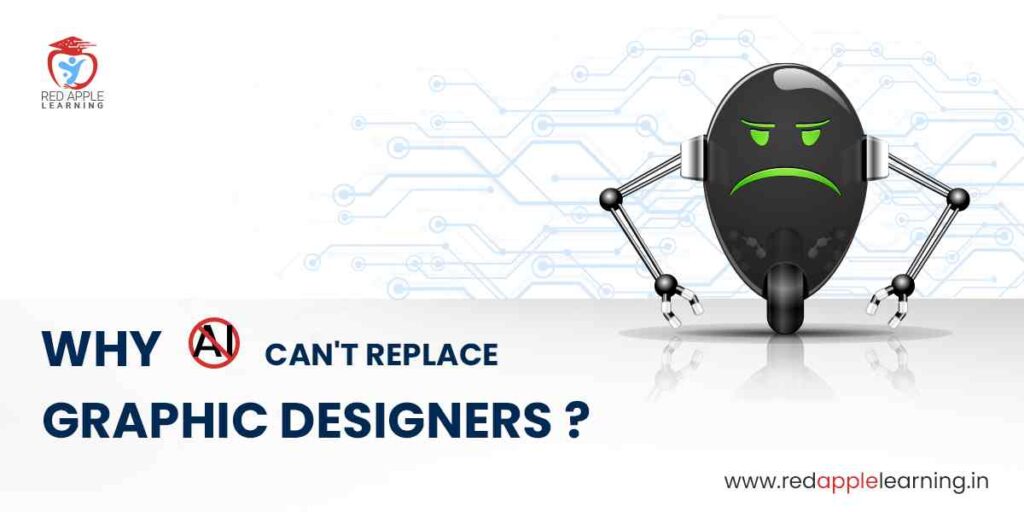Why AI can’t Replace Graphic Designers?
In a rapidly evolving technological landscape, artificial intelligence (AI) has made astonishing strides, revolutionizing numerous industries. Graphic design, too, has experienced the transformative touch of AI, leading to discussions about the potential replacement of graphic designers by machines. While AI has undoubtedly brought efficiency and innovation to the field, the essence of graphic design is deeply rooted in human creativity, intuition, and emotional resonance, making it irreplaceable. Therefore, in this blog, we delve into the multifaceted nature of graphic design and explore the reasons why AI can’t fully take the place of graphic designers.

Why Graphic Designers cannot be Replaced?
Graphic design is an art that encompasses the harmonious interplay of colors, shapes, typography, and visual elements to convey messages, evoke emotions, and tell stories. At its core, graphic design requires creativity that stems from human imagination and intuition. While AI can be programmed to generate designs based on algorithms and data, it lacks the genuine creativity that arises from human experiences, emotions, and cultural contexts. Designers have the ability to think outside the box, infuse their unique perspectives, and create visual narratives that resonate deeply with audiences.
Here We are Providing the Reasons Why Graphic Designing is a “AI-proof” Industry:
Cultural Context and Emotional Resonance
One of the hallmarks of exceptional graphic design is its ability to connect with diverse audiences on an emotional level. Graphic designers possess an innate understanding of cultural nuances, societal trends, and human psychology, allowing them to tailor designs that strike a chord with specific target groups. Unlike AI, human designers can infuse designs with cultural references, symbolism, and metaphors that resonate with local communities, fostering a sense of familiarity and emotional connection that is undoubtedly challenging for AI to replicate.
Iterative Design Process and Intuition
The design process is rarely linear; it involves multiple iterations, refinements, and adjustments based on feedback. Human designers employ their intuition to make crucial decisions during this process, responding to the evolving needs and preferences of clients and audiences. They can perceive subtle nuances that might not be explicitly outlined in a brief and translate these insights into impactful design choices. The graphic designers are skilled in each and every aspect. This intuitive aspect of design cannot be effectively replicated by AI, as it lacks the inherent ability to understand and interpret the complexity of human interactions and preferences.
Adaptability and Innovation
Graphic design is a dynamic field that constantly evolves in response to technological advancements and changing aesthetic trends. While AI can automate certain design tasks, it struggles to adapt swiftly to emerging design styles and trends. Graphic designers are adept at embracing new tools and techniques, experimenting with innovative concepts, and pushing the boundaries of creativity. Their ability to learn, unlearn, and relearn allows them to stay at the forefront of design innovation, a quality that is challenging for AI to emulate without human guidance.
Human-Centered Design and Empathy
Effective graphic design often revolves around creating experiences that cater to human needs, desires, and emotions. Designers place a strong emphasis on user-centered design, focusing on creating interfaces and visuals that are not only aesthetically pleasing but also intuitive and functional. The incorporation of empathy into design decisions is a uniquely human trait. Designers can put themselves in the shoes of the end-users, anticipate their reactions, and design accordingly, resulting in designs that are more meaningful and user-friendly.
The Art of Storytelling
AI doesn’t have any feelings and the art of story telling lies in the emotions of humans! Graphic design is more than just arranging visual elements on a canvas; it’s about telling stories and conveying messages in a compelling manner. Whether it’s through a logo, a poster, or a website, designers have the ability to weave narratives that engage, inform, and captivate audiences. Storytelling requires an understanding of narrative structure, pacing, and emotional arcs – qualities deeply rooted in human creativity and consciousness.
Collaboration and Communication
Graphic design projects often involve collaboration with clients, copywriters, marketers, and other stakeholders. Effective communication, interpretation of feedback, and alignment of creative visions are crucial for the success of these collaborations. Graphic designers not only bring their design skills to the table but also their ability to foster open dialogue and build strong working relationships, facilitating the seamless execution of design projects.
To Wrap Up
While AI has undoubtedly brought remarkable advancements to the field of graphic design, it remains clear that the realm of creative expression, emotional resonance, cultural sensitivity, intuition, adaptability, and empathy is where human graphic designers truly shine. The unique blend of skills and qualities that designers possess – creativity, empathy, cultural awareness, intuition – collectively form an essence that is intrinsically human and cannot be fully replicated by machines. Therefore, it can be confidently stated that aspiring graphic designers need not feel apprehensive, as AI cannot supplant humans as long as they possess the requisite skills. Gain your skills with the assistance of our graphic designing courses. As technology continues to evolve, the symbiotic relationship between AI tools and human designers will likely yield the most innovative and impactful design outcomes, underscoring the fact that the role of graphic designers is not merely functional, but deeply human and irreplaceable.
